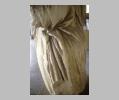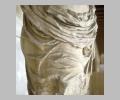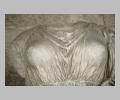
Themis or Demokratia, detail of drapery on right hip

Themis or Demokratia, detail of left side

Themis or Demokratia, detail of lower torso

Themis or Demokratia, detail of left shoulder

Themis or Demokratia, detail of right side

Themis or Demokratia, detail of upper torso
| Collection: | Athens, Agora Museum |
| Title: | Statue of a goddess |
| Context: | From Athens, Agora |
| Findspot: | Excavated at Athens, Agora (found in 1970 built into a Byzantine wall in front of the Royal Stoa). |
| Summary: | Personification of Themis or possibly Demokratia |
| Material: | Marble |
| Sculpture Type: | Free-standing statue |
| Category: | Single sculpture? |
| Placement: | On a base in front of the Royal Stoa |
| Style: | Late Classical |
| Technique: | In-the-round |
| Original or Copy: | Original |
| Date: | ca. 350 BC - ca. 325 BC |
| Dimensions: | H. 1.54 m (H. restored ca. 2.95) |
| Scale: | Colossal |
| Region: | Attica |
| Period: | Late Classical |
Subject Description: Colossal female figure probably representing a personification. Themis (Justice), Demokratia, and Tyche (Fortune) have been suggested. Found one meter from a large base immediately in front of the Royal Stoa. On the theory that the colossus would not have moved far and hence should be connected with this base and the Royal Stoa, and because of her resemblance to a slightly later statue of Themis from Rhamnous (Attica) for which she may have served as a prototype, Themis is the most likely identification. Since references to a cult of Demokratia do appear in Athens in the 330s and at least one such statue was set up in this area, that identification cannot be excluded. The statue held a long metal staff or spear in the crook of her left arm.
Form & Style: Figure wears a chiton of thin, crinkly fabric, almost transparent where it is stretched tight over the body. Breasts and stomach appear almost bare. Shoulder cord girt high under breasts further emphasizes body and probably has iconographic significance as well. Himation hangs low and loose around right hip, forming series of horizontal folds over projecting leg. Heavy use of running drill, though not such long stretches as appear in slightly later sculpture. Stands at head of Hellenistic tradition.
Date Description: A more specific dating of ca. 340-330 B.C. has been suggested by several scholars.
Condition: Single piece
Condition Description: Torso broken just above knees, below shoulder of right arm and below elbow of left (which was doweled). Inset head and neck now missing.
Material Description: Pentelic Marble
Associated Building: Athens, Stoa Basileios (Royal Stoa)
Sources Used: